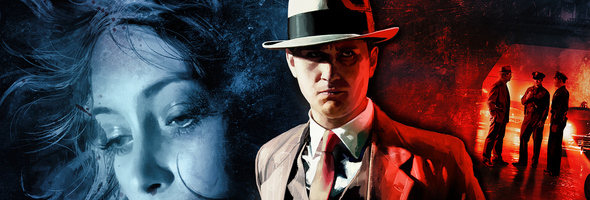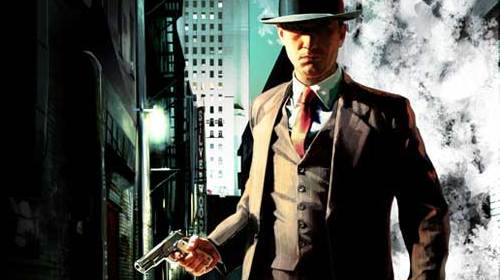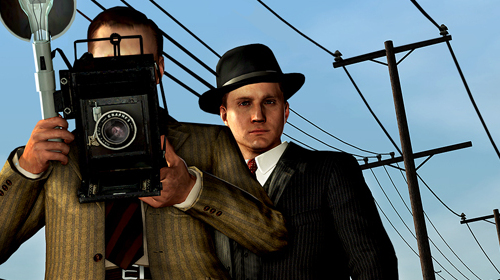
It’s a very rare game that allows the player to step into the shoes of a police officer; rarer still is the game that treats the player as an adult and faces them with the horrors of real-life crime. L.A. Noire, developed over an eight-year time period by Sydney, Australia based Team Bondi with assistance from Rockstar, follows the life of Cole Phelps, a Pacific Theater war hero turned star Police detective in the year 1947. One of the major features of L.A. Noire is the detective aspect and the use of sophisticated facial mapping technology in order to properly convey subtle (and not so subtle) emotions on your suspect’s faces when you’re putting the spotlight on them.
While L.A. Noire can dismissively be described as “1940s GTA”, nothing could be further from the truth. Much like Rockstar’s last marquee game, L.A. Noire steps out of GTA’s shadow by establishing its own identity by giving gamers something new and different in an increasingly crowded market. Come inside the GamerSushi interview room and see if we can sweat the facts out of this flatfoot.
L.A. Noire starts out simply enough with Cole taking on the role of a patrolman, learning the ropes of basic investigative work and how to properly get a confession out of suspects. It’s only once Cole’s superiors realize the potential in the young war hero that the game really gets into the thick of things, throwing you into complex cases and making you do the leg work to solve the crime. Starting on the traffic desk and ending on arson, each different department functions like a season of a TV show, complete with the 1940s style intro that sets up the case. While each assignment has the same basic structure of investigate the crime scene, find clues and interrogate witnesses, the detective work is so challenging and fun that you’ll hardly notice the sometimes repetitive nature of the game.
The developers sometimes throw little diversions into the individual cases to break them up, like car chases and shoot outs, but most of the time you’ll be scrounging for clues and pressing witnesses for information. The way this works is that you guide Cole through each scene, waiting for the controller to vibrate in order to get the notification that you can inspect a clue. When you’ve found something pertinent to the crime, it gets added to your notebook and you can use it later to build your case and maybe catch someone on a lie. Figuring out how each little scrap fits into the larger picture is some of the most rewarding gameplay I’ve experienced in the last while, and the musical cues that go with it are so perfectly integrated that it’s a while before your brain consciously thinks of them as a mechanic.
Once you’ve got the original crime scene locked down, you’ll usually spend some time chasing down leads and grilling suspects, and this is where L.A. Noire’s facial animation comes into full swing. Using your notebook and a series of questions, you try to get a sense of whether or not the person you’re talking to is telling the truth or holding out on you. Your discussion options come in three flavors: Truth, Doubt and Lie, the last one being the most tricky; unlike the first two, you need to have some solid evidence to back up your accusations. Catching someone lying is always a great victory, but when you bungle a question, you bungle it badly. Pick truth at the wrong time and you might miss out on an important person of interest, or doubting someone may lead to them becoming hostile with you, throwing off your line of questioning. The real key to this is reading each characters’ facial animations and reacting to that, which makes the tech behind it even more impressive.
There have been some great games in the past that have done facial animation really well like Red Dead Redemption and (for me, anyways) Halo: Reach, but L.A. Noire is leagues beyond that. There are several well known actors in the game, and it’s almost scary how well the game’s engine can recreate their faces. Unlike Heavy Rain, though, the faces don’t extend into the Uncanny Valley territory; all of the expressions are believable and well done without being uncomfortable to look at. L.A. Noire also boasts some strong writing and voice acting, really tying everything together. There is the odd line that doesn’t hit quite as well, but it’s few and far between. If I was given a choice between seeing Heavy Rain’s style versus L.A. Noire’s in future games, I’d pick L.A. Noire hands down. It’s unfortunate that the game is so memory intensive that it needs to be run on three discs on the Xbox 360, but it’s worth it considering how amazing the faces are.
Cole Phelps is also a very interesting character who starts out as a simple, straight-laced cop who’s almost so flat that he could have stepped out of a recruiting poster. Only as the game goes on do you realize that Cole is just as flawed as everyone else and his earlier rigid attitude is a mask, a persona he wears when he’s on the job. The between cases World War 2 flashbacks also expand on Cole’s character, meaning that as the game goes on you learn more about Phelps and why he is the way he is. There are a few missteps here, but once you hit the final blow and land in arson, the tone is a real gut punch. For all his professionalism and high-handedness, even the seemingly perfect Cole Phelps can’t escape from the corrupting presence of Los Angeles.
Team Bondi has paid just as much attention to the setting as they have to the actors in the world, giving their 1940’s Los Angeles a great atmosphere and a believable presence. In a city of glitz and glamor where the wrong turn could mean you wind up on a cold slab in the morgue, the City of Angels is just as important a player on this stage. As the opening menu touts, the Downtown core of L.A. is recreated right down to the signs on the buildings. The developers put so much attention to detail into this game, it’s easy to temporarily blind yourself to the game’s various faults.
That being said, I don’t think I’d be fair if I didn’t point out the flaws that L.A. Noire has, just for balance. The shooting, driving and walking controls are fairly clunky, even if Team Bondi did do a lot to streamline the more trickier aspects of navigation like climbing fire escapes. The pedestrian/driving AI is also pretty brain dead, meaning that just driving around L.A. during your cases will lead to several incidents where you’ll be forced to do some tricky maneuvering if you don’t want to run into a bunch of cars and ruin your rating. As another knock against the driving, the car chases are particularly onerous, quickly leading to the conclusion that these are merely time wasters as opposed to a test of your skills. While your partner will give you the impression that you can bring a chase to a halt by slamming your car into the suspects, trying to clip the rear end of a vehicle will simply make you bounce off instead of spinning out the other car. Sometimes your fellow detective will shoot out the tires of the fleeing auto, but most of the time you just follow the perp until they crash.
The in-between cases stuff is also pretty samey, mostly consisting of fetch quests and random street crimes which make use of L.A. Noire’s weaker gameplay aspects. While they are useful for gaining experience points and leveling to gain Intuition Points for use in interviews, the sheer number of these (40 in total) means that you’ll probably avoid them after completing the first few.
When L.A. Noire is firing on all cylinders, it’s an engrossing and fresh experience presenting you with a new way to think about games and what we can do with them. The unfortunate thing is that, as polished as L.A. Noire is in some respects, the rest of it kind of feels slap-dash. Given the care that some facets of the game received, it’s sometimes jarring to make the transition to a mechanic that clearly didn’t receive as much attention from the developers.
L.A. Noire is a mature tale of 1940s detective work, but if you’re looking for the kind of random destruction GTA offers, look elsewhere. L.A. Noire treats you like an adult, and expects you to act as such.
So, that’s the GamerSushi consensus on L.A. Noire. It’s really strong where it wants to be, but stumbles in a few too many areas to be perfect. What do you guys think of the game? Did you love it or hate it?
GamerSushi Score:

How does our grading system work? Check out our grade chart!



I was waiting to see if someone did a review. If not I wanted to. To be honest, I would love to talk about the game with you guys in a podcast or something, I have a lot to say on it.
I agree with the rating of an A. I think if the story had gone a different rout, I would have maybe been more inclined to say an S, thats maybe though. The game is great, still up for GOTY in my opinion. As I said I didnt like how the story ended and also didn’t like the way the game ended, with its Fallout 3 style of ‘game over and cant continue’. Loved the setting, the faces, and the gameplay. Great tittle. Will be playing again to get 100%
Would also like to make mention of this, if you read the facts in the Social Club, the game was 90% accurate in the re-creation of the city. Way to go rockstar.
Very good review. I agree with almost all of the points.
It was great to discover who Cole really was and about his past. I’d say the ending was well done and well thought out, but it just doesn’t sit well with me. I loved finding clues, interviewing people, and solving the crimes. The facial animations are astounding.
Just a small note, you are able to disable the cars before they crash or before your partner shoots the wheels by smashing into them, you just need to either do it a lot, or manage to smash into them at full speed from the side, it was pretty tricky.
I didn’t have problems with the driving after I was used to it, like the horses in RDR, but i did occasionally have trouble with the walking controls, and controls in combat were often a problem.
I agree with the grade 100%.
Great review, Mitch. I just finished the game over the weekend and while I’m very happy with the experience, I do have to say the ending left a bit to be desired. The ride itself for those last few hours was a blast, but the actual conclusion of it fell flat for me. That being said, the rest of the came stands out so much it’s sort of easy to forgive it.
And Sean, we already talked about it on the last podcast we recorded. Sorry, bud 🙁